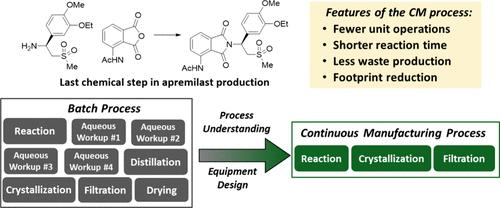当前位置:
X-MOL 学术
›
Org. Process Res. Dev.
›
论文详情
Our official English website, www.x-mol.net, welcomes your
feedback! (Note: you will need to create a separate account there.)
A Continuous Process for Manufacturing Apremilast. Part I: Process Development and Intensification by Utilizing Flow Chemistry Principles
Organic Process Research & Development ( IF 3.1 ) Pub Date : 2024-02-02 , DOI: 10.1021/acs.oprd.3c00400 Hsiao-Wu Hsieh 1 , Carolyn M. Cohen 1 , Daniel J. Griffin 1 , Padmini Ananthoji 1 , Nadide Hazal Avci 1 , Derek B. Brown 2 , Ari Ericson 2 , James D. Fostinis 1 , Muhammad Irfan 1 , Neil Langille 1 , Michael A. Lovette 2 , James I. Murray 2 , Simone Spada 1 , Oliver R. Thiel 1 , Frankie Aiello 3 , Joseph Daou 3 , Nicole Goudas-Salomon 3 , Ende Pan 3 , Nandini Sarkar 3 , Rasangi Wimalasinghe 3 , Zufan Steven Wu 3 , Alicia Zeng 3 , Matthew G. Beaver 1
Organic Process Research & Development ( IF 3.1 ) Pub Date : 2024-02-02 , DOI: 10.1021/acs.oprd.3c00400 Hsiao-Wu Hsieh 1 , Carolyn M. Cohen 1 , Daniel J. Griffin 1 , Padmini Ananthoji 1 , Nadide Hazal Avci 1 , Derek B. Brown 2 , Ari Ericson 2 , James D. Fostinis 1 , Muhammad Irfan 1 , Neil Langille 1 , Michael A. Lovette 2 , James I. Murray 2 , Simone Spada 1 , Oliver R. Thiel 1 , Frankie Aiello 3 , Joseph Daou 3 , Nicole Goudas-Salomon 3 , Ende Pan 3 , Nandini Sarkar 3 , Rasangi Wimalasinghe 3 , Zufan Steven Wu 3 , Alicia Zeng 3 , Matthew G. Beaver 1
Affiliation

|
Herein, we report the development of an integrated continuous manufacturing (CM) process for the penultimate step in the synthesis of apremilast, the drug substance (DS) of the commercial product Otezla. This development effort was motivated by the desire to create an alternative manufacturing configuration with a significantly smaller footprint and to impart intensification resulting in a more sustainable process. Three primary aspects of the existing batch process had to be addressed to achieve this goal: (1) long reaction time, (2) low solubility of the starting materials and intermediates in the primary reaction solvent (THF), and (3) extensive postreaction unit operations contributing to significant solvent waste. Key features of the intensified CM process include the following: (1) use of a plug-flow reactor (PFR) to access increased reaction temperatures (130 °C), resulting in a shorter reaction time to reach the target conversion (>18 h in batch to 30 min in flow); (2) replacement of THF with DMSO to solve solubility issues related to starting materials and reaction intermediates, and (3) development of a multistage continuous MSMPR (mixed-suspension, mixed-product removal) crystallization upon addition of water as antisolvent to the end-of-reaction stream containing apremilast. This intensified CM process reduced the number of primary unit operations from nine to three (67% reduction). Moreover, it can be executed at commercial scale using a compact manufacturing skid. Part I of this manuscript series highlights the effort to develop the novel process and the corresponding kg-scale demonstration of the optimized process. Part II describes the process characterization and development of a control strategy in detail to ensure process efficiency and robustness of the small-footprint continuous skid.
中文翻译:

Apremilast 的连续生产工艺。第一部分:利用流动化学原理进行工艺开发和强化
在此,我们报告了阿普斯特(商业产品 Otezla 的原料药(DS))合成倒数第二步的集成连续制造(CM)工艺的开发。这项开发工作的动机是希望创建一种占地面积显着更小的替代制造配置,并实现集约化,从而实现更可持续的流程。为了实现这一目标,必须解决现有间歇工艺的三个主要问题:(1) 反应时间长,(2) 起始原料和中间体在主要反应溶剂 (THF) 中的溶解度低,以及 (3) 大量的后反应单元操作造成大量溶剂浪费。强化CM工艺的主要特点包括:(1)使用推流反应器(PFR)来提高反应温度(130°C),从而缩短达到目标转化率的反应时间(>18小时)分批到流动 30 分钟); (2)用DMSO替代THF,解决与起始原料和反应中间体相关的溶解度问题,以及(3)开发多级连续MSMPR(混合悬浮液,混合产物去除)结晶,最终添加水作为反溶剂含有阿普斯特的反应流。这种强化的 CM 流程将主要单元操作的数量从 9 个减少到 3 个(减少 67%)。此外,它可以使用紧凑的制造台架以商业规模实施。本手稿系列的第一部分重点介绍了开发新工艺的努力以及优化工艺的相应公斤级演示。第二部分详细描述了过程特征和控制策略的开发,以确保小占地面积连续撬的过程效率和稳健性。
更新日期:2024-02-02
中文翻译:

Apremilast 的连续生产工艺。第一部分:利用流动化学原理进行工艺开发和强化
在此,我们报告了阿普斯特(商业产品 Otezla 的原料药(DS))合成倒数第二步的集成连续制造(CM)工艺的开发。这项开发工作的动机是希望创建一种占地面积显着更小的替代制造配置,并实现集约化,从而实现更可持续的流程。为了实现这一目标,必须解决现有间歇工艺的三个主要问题:(1) 反应时间长,(2) 起始原料和中间体在主要反应溶剂 (THF) 中的溶解度低,以及 (3) 大量的后反应单元操作造成大量溶剂浪费。强化CM工艺的主要特点包括:(1)使用推流反应器(PFR)来提高反应温度(130°C),从而缩短达到目标转化率的反应时间(>18小时)分批到流动 30 分钟); (2)用DMSO替代THF,解决与起始原料和反应中间体相关的溶解度问题,以及(3)开发多级连续MSMPR(混合悬浮液,混合产物去除)结晶,最终添加水作为反溶剂含有阿普斯特的反应流。这种强化的 CM 流程将主要单元操作的数量从 9 个减少到 3 个(减少 67%)。此外,它可以使用紧凑的制造台架以商业规模实施。本手稿系列的第一部分重点介绍了开发新工艺的努力以及优化工艺的相应公斤级演示。第二部分详细描述了过程特征和控制策略的开发,以确保小占地面积连续撬的过程效率和稳健性。






























 京公网安备 11010802027423号
京公网安备 11010802027423号